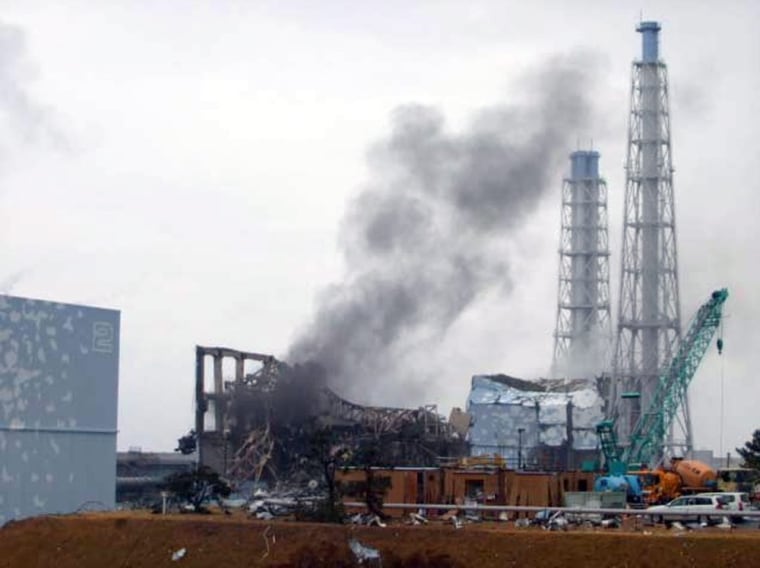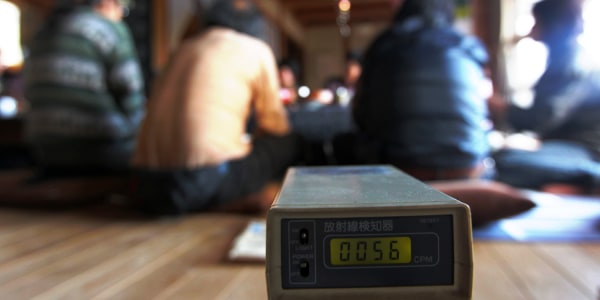Officials are racing to restore electricity to Japan's leaking nuclear plant, but getting the power flowing will hardly be the end of their battle: With its mangled machinery and partly melted reactor cores, bringing the complex under control is a monstrous job.
Restoring the power to all six units at the tsunami-damaged complex is key, because it will, in theory, drive the maze of motors, valves and switches that help deliver cooling water to the overheated reactor cores and spent fuel pools that are leaking radiation.
Ideally, officials believe it should only take a day to get the Fukushima Dai-ichi nuclear under control once the cooling systems are up and running. But it could take days or weeks to get those systems working.
"We have experienced a very huge disaster that has caused very large damage at a nuclear power generation plant on a scale that we had not expected," Hidehiko Nishiyama, deputy director general of Japan's Nuclear and Industrial Safety Agency, told reporters late Monday.
The nuclear plant's cooling systems were wrecked by the massive earthquake and tsunami that devastated northeastern Japan on March 11. Since then, conditions at the plant have been volatile; plumes of smoke rose from two reactor units Monday, prompting workers to evacuate units 1-4.
Slideshow 9 photos
After Japan's earthquake and tsunami - week 8
Tokyo Electric Power Co said on Tuesday it resumed work on restoring power to the reactors after checking that the smoke had turned to steam.
"Steam was coming out from before," a TEPCO spokesman said. "We judged it was safe to continue work."
The high-stakes drama at the battered complex is playing out while the Asian nation grapples with the aftermath of the quake and tsunami that left at least 21,000 people dead or missing.
Key systems damaged
Technicians working inside an evacuation zone around the stricken plant on Japan's northeast Pacific coast managed to attach power cables to all six reactors and started a water pump at one of them to cool overheating nuclear fuel rods.
"We see a light for getting out of the crisis," an official quoted Prime Minister Naoto Kan as saying, allowing himself some rare optimism in Japan's toughest moment since World War II.
But in another setback, the plant's operator said Monday it had just discovered that some of the cooling system's key pumps at the complex's troubled Unit 2 are no longer functional — meaning replacements have to be brought in. TEPCO said it placed emergency orders for new pumps, but it was unclear how long it would take for them to arrive.
If officials can get the power turned on, get the replacement pumps working and get enough seawater into the reactors and spent fuel pools, it would only take a day to bring the temperatures back to a safe, cooling stage, said Ryohei Shiomi, an official with the Nuclear and Industrial Safety Agency.
And if not?
"There is nothing else we can do but keep doing what we've been doing," Shiomi said.
In other words, officials would continue dousing the plant in seawater — and hope for the best.
An official of the U.S. Nuclear Regulatory Commission said in Washington that Units 1, 2 and 3 have all seen damage to their reactor cores, but that containment is intact. The assessment dispels some concerns about Unit 2, where an explosion damaged a pressure-reducing chamber around the bottom of the reactor core.
"I would say optimistically that things appear to be on the verge of stabilizing," said Bill Borchardt, the commission's executive director for operations.
Radiation fears
The Japanese government said there was no need to extend the 20 km (12 mile) evacuation zone around the plant. "At the moment, there is no need to expand the evacuation area," Chief Cabinet Secretary Yukio Edano told a briefing.
Latest available readings from an area 10 km (6 miles) outside the evacuation zone show a level of 110 microsieverts per hour in the air, well below a level that would cause health risks but much higher than normal background levels.
It is unclear what background levels would have been this far away from the plant before the tsunami struck, but a reading of 110 microsieverts is roughly 3,000 times Tokyo's normal pre-disaster background level.
Yet away from the plant, evidence of small amounts of radiation in vegetables, water and milk spread jitters among Japanese and abroad despite officials' assurances levels were not dangerous.
TEPCO said radiation had been found in the waters of the Pacific nearby, perhaps not surprising given crews have been dousing the reactors with seawater ever since the accident.
Radioactive iodine in the sea samples was 126.7 times the allowed limit, while cesium was 24.8 times over, Kyodo news agency said. That still posed no immediate danger, TEPCO said.
"It would have to be drunk for a whole year in order to accumulate to one millisievert," a TEPCO official said, referring to the standard radiation measurement unit. People are generally exposed to about 1 to 10 millisieverts each year from background radiation caused by substances in the air and soil.
Japan has urged some residents near the plant to stop drinking tap water after high levels of radioactive iodine were detected. It has also stopped shipments of milk, spinach and another local vegetable called kakina from the area.
"Radiation levels exceeding provisional standards have been found (in some products)," Chief Cabinet Secretary Yukio Edano said. "What I want the people to understand is that their levels are not high enough to affect humans. Eating these products just a couple of times would not affect people's health."
Experts say readings are much lower than around Chernobyl after the 1986 accident in Ukraine. Some warned against panic.
"You would have to eat or drink an awful lot to get any level of radiation that would be harmful," said Laurence Williams, professor of nuclear safety at the John Tyndall Institute in Britain.
"We live in a radioactive world — we get radiation from the earth, from the food we eat. It's an emotive subject and the nuclear industry and governments have got to do a lot more to educate people."

There were no major reports of contaminated food in Tokyo, a city of about 13 million where many are staying indoors or wearing face masks. Some expatriates and locals left last week right after the accident.
Japan is a net importer of food, but has substantial exports — mainly fruit, vegetables, dairy products and seafood — with its biggest markets in Hong Kong, China and the United States.
Jitters abroad
China said it is monitoring food imports from Japan but also took a swipe against panic by jailing a man for 10 days for spreading rumors about contamination of its waters.
State media said the computer company worker, who had urged people to avoid sea products for a year, was also fined 500 yuan ($76.13) and had confessed to "deep awareness of his mistake."
South Korea is expanding inspection to processed and dried agricultural Japanese food, from just fresh produce.
And in Taiwan, a top Japanese restaurant is offering diners a radiation gauge in case they are nervous about the food.
A senior defense official confirmed to NBC News that the U.S. military is distributing potassium iodide tablets to all sailors and their families at Yokosuka Naval Base and Atsugi Naval Air Base in Japan.
Like the U.S. government officials who will get the tablets in much of Honshu, the sailors and their families have not been advised to take the tablets yet — and are warned not to take them unless instructed.
The U.S. is also moving the aircraft carrier USS George Washington away from Japan as a precaution because of concerns that long-term exposure to radiation will damage the ship.
U.S. military families continue to depart Japan on the voluntary evacuation order. There were seven flights scheduled to depart Japan on Tuesday, carrying approximately 1,800 family members to either Seattle or Denver.
In a symbolic boost for Japan, billionaire investor Warren Buffett said the earthquake and tsunami were an "enormous blow" but in fact presented a "buying opportunity." for Japanese stocks.
An official of the U.S. Nuclear Regulatory Commission said in Washington that Units 1, 2 and 3 have all seen damage to their reactor cores, but that containment is intact. The assessment dispels some concerns about Unit 2, where an explosion damaged a pressure-reducing chamber around the bottom of the reactor core.
"I would say optimistically that things appear to be on the verge of stabilizing," said Bill Borchardt, the commission's executive director for operations.
What caused the smoke to billow first from Unit 3 and then from Unit 2 on Monday was under investigation, nuclear safety agency officials said. In the days since the earthquake and tsunami, both units have overheated and seen explosions outside their reactor cores.
Workers were evacuated from the area to buildings nearby, though radiation levels remained steady, the officials said. It was a setback in efforts to rewire the plant, where officials had hoped to finish connecting all six reactor units to the grid on Tuesday.
Problems set off by the disasters have ranged far beyond the shattered northeast coast and the wrecked nuclear plant, handing the government what it has called Japan's worst crisis since World War II. Rebuilding may cost as much as $235 billion.
The World Bank said in a report Monday that Japan may need five years to rebuild from the disasters, which caused up to $235 billion in damage, saying the cost to private insurers will be up to $33 billion and that the government will spend $12 billion on reconstruction in the current national budget and much more later.
